
94% of researchers rate our articles as excellent or good
Learn more about the work of our research integrity team to safeguard the quality of each article we publish.
Find out more
ORIGINAL RESEARCH article
Front. Chem. , 03 September 2020
Sec. Catalysis and Photocatalysis
Volume 8 - 2020 | https://doi.org/10.3389/fchem.2020.00773
This article is part of the Research Topic Design, Synthesis, and Environmental Applications of Novel Semiconductor-Mediated Photocatalysts View all 4 articles
Er3+/Yb3+ co-doped Bi5O7I uniform porous microsphere photocatalysts were synthesized by a two-step chemical method, which possesses excellent photocatalytic performance and upconversion luminescence property. The photocatalytic performance of the photocatalysts was studied by degradation of bisphenol A in aqueous solution under visible light and different monochromatic light irradiation. The photocatalytic performance of Er3+/Yb3+ co-doped Bi5O7I sample is better than that of the pristine Bi5O7I and Er3+-doped Bi5O7I samples. Moreover, Er3+/Yb3+ co-doped Bi5O7I possesses photocatalytic ability with a red light monochromatic LED lamp (3 W, λ = 630 nm) and an infrared monochromatic LED lamp (100 W, λ = 940 nm) irradiation whose wavelength is longer than the absorption-limiting wavelength of pristine Bi5O7I sample. This phenomenon further verified that the upconversion property of Er3+ and Yb3+ causes the improved photocatalytic efficiency of Er3+/Yb3+ co-doped Bi5O7I sample.
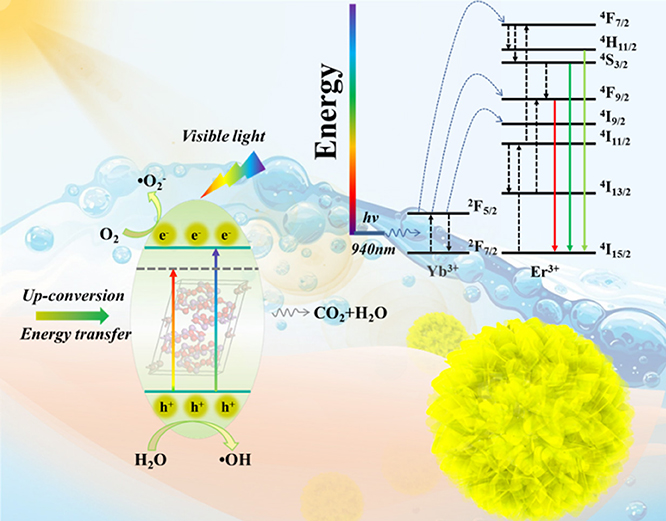
Graphical Abstract. Er3+/Yb3+ co-doped Bi5O7I porous microsphere photocatalysts show efficiency photocatalytic properties for bisphenol A degradation under visible and near-infrared light irradiation.
Upconversion is a particular type of photoluminescence (PL), which converts low-energy excitation light into high-energy emission light through a multiphoton absorption process (Obregón and Colón, 2014a; Chuai et al., 2015; Ma et al., 2015; Fu et al., 2017). For this excellent characteristic, many upconverting materials, such as YF3 and NaYF4, have been used as powerful assistants to combine with semiconductor photocatalysts to improve light utilization recently (Huang et al., 2012; Li et al., 2013). For instance, Qin et al. (2010) reported that the graphene-supported NaYF4:Yb3+, Tm3+, and N-doped P25 nanocomposite photocatalysts exhibit outstanding photocatalytic efficiency, because upconverting materials can effectively convert long-wavelength infrared (IR) light into short-wavelength light (such as visible light). The semiconductors in the composite photocatalysts can absorb the converted short-wavelength light to make full use of incident light. However, many up-conversion materials did not have photocatalytic performance because of their large band gap (Wang et al., 2013; Xu et al., 2013). Therefore, it is important to fabricate single-phase photocatalyst with excellent photocatalytic activity and upconversion property.
Bi5O7I as a novel semiconductor photocatalytic material with an optical band gap of ~2.8 eV has received a lot of attention (Zhang et al., 2020a). The lamellar crystallographic structure of Bi5O7I can form an internal electrostatic field whose direction is vertical to the atom layer. The internal electrostatic field can promote the separation of photo-generated electron-hole pairs (Lan et al., 2020). However, the shortcomings of low light absorption and transmission efficiency of carriers still limit its photocatalytic activity. It is well-known that combining Bi5O7I with other semiconductors to form heterojunction could improve the separation rate of photo-generated charge carriers and show enhanced photocatalytic efficiency for pollutants degradation (Liu et al., 2015; Zhang et al., 2020b). In addition, our previous report indicated that the doping of Er3+ into the Bi5O7I can broaden the photo-response range due to the upconversion effect (Hojamberdiev et al., 2020), but the light conversion is not thorough enough. It can be inferred that the Er3+/Yb3+ co-doping would cause more intensive upconversion fluorescence effect (Ding et al., 2016), which can enhance photocatalytic degradation properties for pollutions with full spectral solar light response.
In this work, uniform Er3+/Yb3+ co-doped Bi5O7I microsphere photocatalysts were prepared by a two-step hydrothermal and thermal–decomposition method. The as-prepared photocatalysts have excellent photocatalytic performance and upconversion luminescence property. From the results of photocatalytic performance tests under the illumination of visible and monochromatic light and trapping experiments, the detailed mechanism of improved photocatalytic activity was also proposed.
The synthesis methods of Bi5O7I and 6%Er3+-doped Bi5O7I samples are detailed in the Supporting Information and the prepared samples were recorded as BOI and 6EBOI, respectively. In addition, the synthesis method of Yb3+/Er3+ co-doped Bi5O7I samples was similar to that previously reported (Zhang et al., 2019), except the addition of 2 to 18% Yb(NO3)3 6H2O. The prepared samples were recorded as 2Y6EBOI, 4Y6EBOI, 6Y6EBOI, 12Y6EBOI, and 18YEBOI, respectively. The characterization and photocatalytic test are also described in the Supporting Information.
The XRD patterns of 6EBOI and YEBOI samples are shown in Figure 1, and all the prepared samples are crystallized well. As previously reported, the Bi5O7I synthesized without any doping corresponds with orthorhombic phase Bi5O7I (JCPDS 40-0548) (Hojamberdiev et al., 2020). However, the synthesized 6EBOI sample is in accordance with orthorhombic phase Bi5O7I and monoclinic phase (JCPDS 38-0669) Bi5O7I. In addition, the phase structure of the samples is completely converted into monoclinic Bi5O7I after doping with Yb3+. Moreover, as the Yb3+ doping content increases, the width of these peaks broadens and the intensity decreases, especially the (004) peak. This is because the doping of Yb3+ and Er3+ limits the growth of Bi5O7I crystals. According to the previous reports, the existence of Yb3+ and Er3+ in the compound can cause phase transition from the orthorhombic phase to the monoclinic phase (Lin et al., 2014; Obregón and Colón, 2014b; Obregón et al., 2014).
Figure 2 displays the scanning electron microscope (SEM) images of the synthesized pure BOI, 6EBOI, and YEBOI samples. As shown in Figure 2a, the BOI sample has a uniform porous spherical morphology with a radius in the range of 1 to 1.5 μm. From Figure 2b, the high-resolution SEM image shows these spheres are stacked by numerous nanosheets. While Figures 2c–f show the SEM images of 6EBOI and 6Y6EBOI samples, respectively. The Yb3+/Er3+ doping has little effect on the morphology, and all the as-prepared samples also have the uniform porous spherical morphology. Energy dispersive spectrometer (EDS) mapping was performed further to analyze the elemental distribution in the 6Y6EBOI sample (Figure 3). It is observed that the Bi, O, I, Er, and Yb elements are well distributed over the whole microsphere.
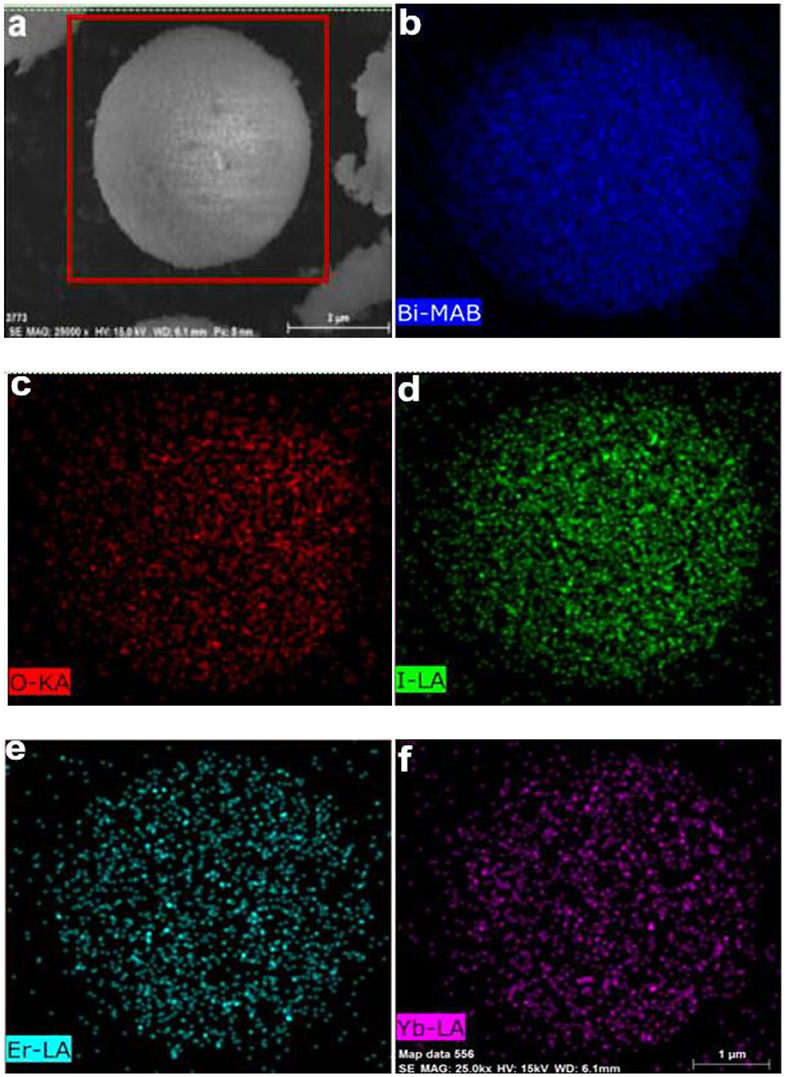
Figure 3. SEM image (a), Bi (b), O (c), I (d), Er (e), and Yb (f) EDS mapping images of 6Y6EBOI sample.
In order to investigate the elemental composition, XPS analysis was performed on the 6Y6EBOI sample, and the consequences are presented in Figure 4. The survey spectrum in Figure 4A clearly reveals the compound consists of Bi, O, I, Er, and Yb elements. There are two peaks at ~164.4 and 158.9 eV (Figure 4B), which are ascribed to Bi 4f7/2 and Bi 4f5/2 (Liu et al., 2017), respectively. In Figure 4C, it is observed that the O 1s peak is located at 529.5 and 531.4 eV, which corresponds to the lattice oxygen and surface-adsorbed oxygen in the prepared sample (Zhu et al., 2019). The peaks located at 619.4 and 630.6 eV (Figure 4D) correspond with the I 3d5/2 and I 3d3/2 (Rao et al., 2019). It is also seen that the Er 4p (Figure 4E) and Yb 4p (Figure 4F) peaks are located at 321.1 and 346.5 eV, which corresponds with the Er3+ and Yb3+ (Hou et al., 2012; Reszczynska et al., 2015), respectively. Thus, the XPS results indicate that the Er3+ and Yb3+ were triumphantly doped into the Bi5O7I sample.
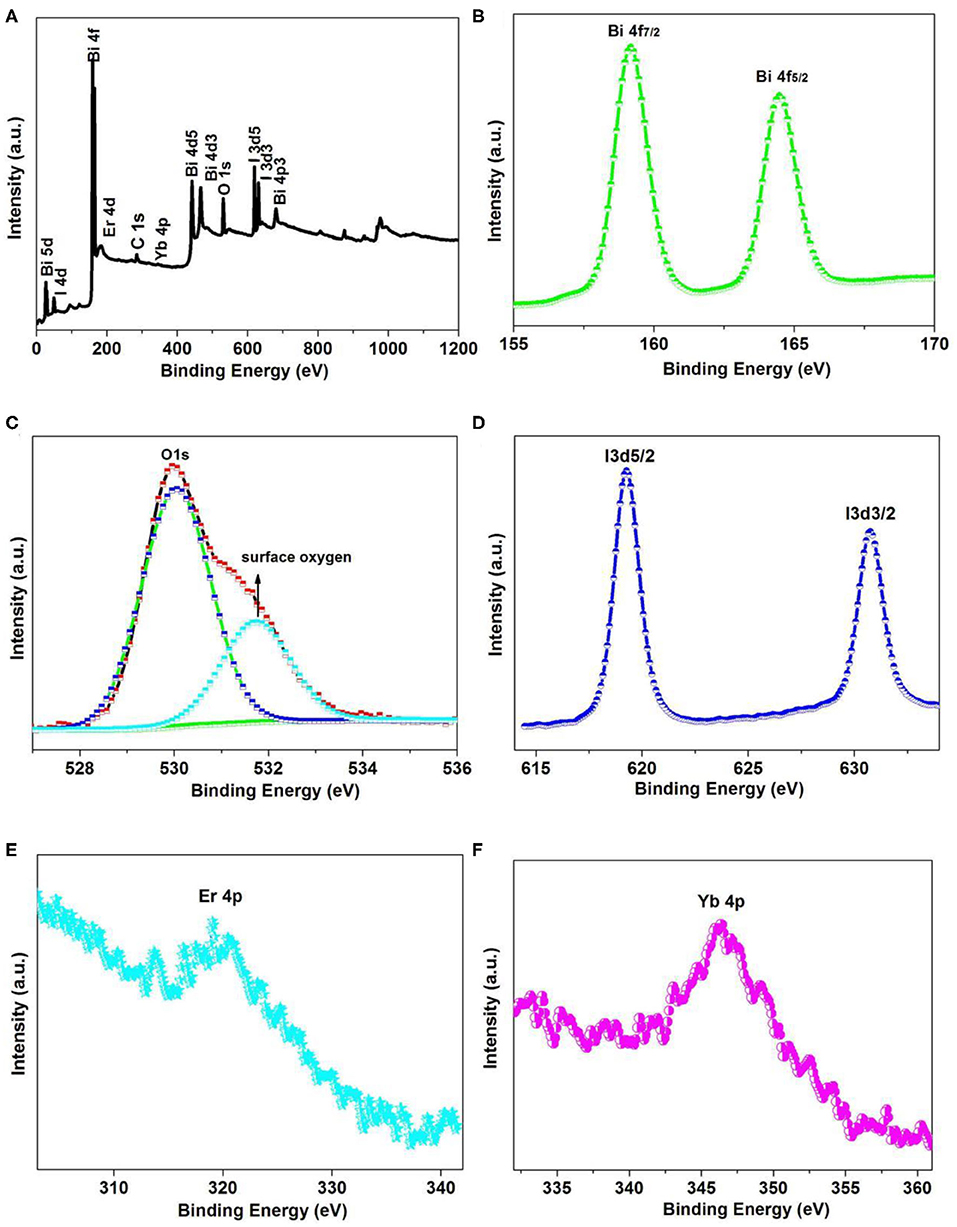
Figure 4. Survey XPS spectra (A), high-resolution XPS spectra of (B) Bi 4f, (C) O 1s, (D) I 3d, (E) Er 4p, and (F) Yb 4p of the 6Y6EBOI sample.
The ultraviolet–visible (UV-vis) absorption spectra of the prepared samples are depicted in Figure 5. The adsorption edge of pure BOI is shorter than 450 nm, indicating that pristine BOI could be excited by the ultraviolet light and a small fraction of visible light. Compared with pure BOI, the visible light absorption of Yb3+/Er3+-doped BOI samples undergoes a significant redshift. It can be seen that three peaks are located at 522, 655, and 797 nm for 6EBOI. This is attributed to the upconversion effect from the 4I15/2 ground state to 2H2/11, 4F9/2, and 4I9/2 states of Er3+ (Rodríguez et al., 2013; Xu et al., 2014). An exception absorption peak at nearly 950 nm for the Yb3+-doped 6EBOI sample is also clearly observed, which is attributed to the upconversion conversion from the 2F5/2 ground state to 2F7/2 states of Yb3+ (Wang et al., 2014).
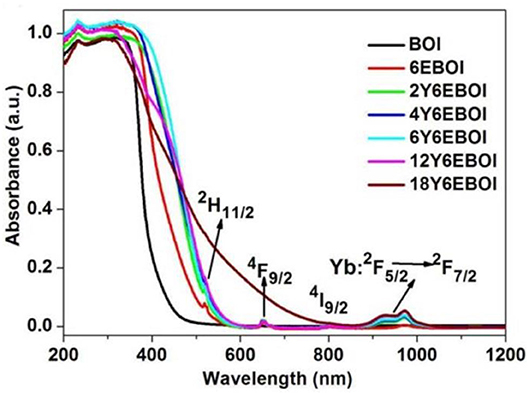
Figure 5. UV-vis adsorption spectra of synthesized pure BOI, 6E BOI, and Yb3+/6%Er3+ co-doped Bi5O7I photocatalysts.
In order to know the cause of these new peaks in the visible and near IR (NIR) light range, the upconversion spectra of YEBOI samples were carried out. Figure 6 exhibits the UC emission spectra (350–800 nm) of YEBOI samples. It shows that there are two green emission bands near 533 and 547 nm, and a red emission band near 654 nm after excitation by an NIR laser (λ = 980 nm). The former between 515 to 538 nm and 540 to 560 nm are ascribed to the and transitions (Zhang et al., 2005; Sun et al., 2011; Mahalingam et al., 2013). The latter between 640 and 680 nm corresponds with the transition of 4F9/2 to 4I15/2. It is very clear that the intensity of the green and red emission bands increases over Yb3+-doped 6EBOI sample. Therefore, the observation results indicate that the new absorption bands appearing in the UV-vis DRS spectra are caused by the upconversion radiation of the YEBOI system (Liu et al., 2013; Bai et al., 2014; Zhou et al., 2015). It is well-known that the lifetime of the upconversion materials exhibits a positive correlation with the upconversion quantum yield (Dai et al., 2013). Thus, the luminescence decay curves of the as-synthesized 6EBOI and 6Y6EBOI are also compared under the excitation light with 650 nm wavelength (Figure 7). The decay curves of 6EBOI and 6Y6EBOI are 184 and 376 μs, respectively. Hence, the lifetime is significantly prolonged after Yb3+dopping compared with the 6EBOI sample. It is concluded that the tendency of lifetime variation is consistent with that of upconversion intensity variation.
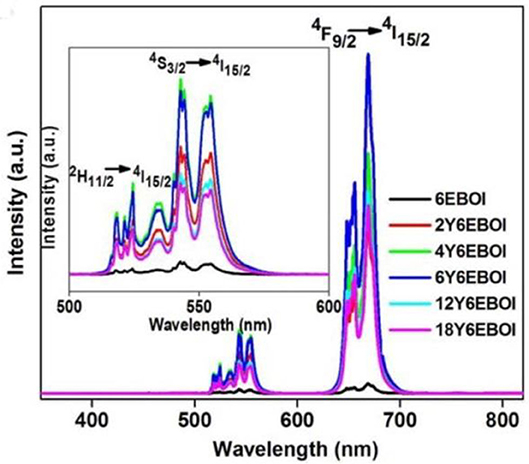
Figure 6. Upconversion spectra of Er3+-doped Bi5O7I; and Yb3+-Er3+co-doped Bi5O7I sample under 980-nm laser excitation.
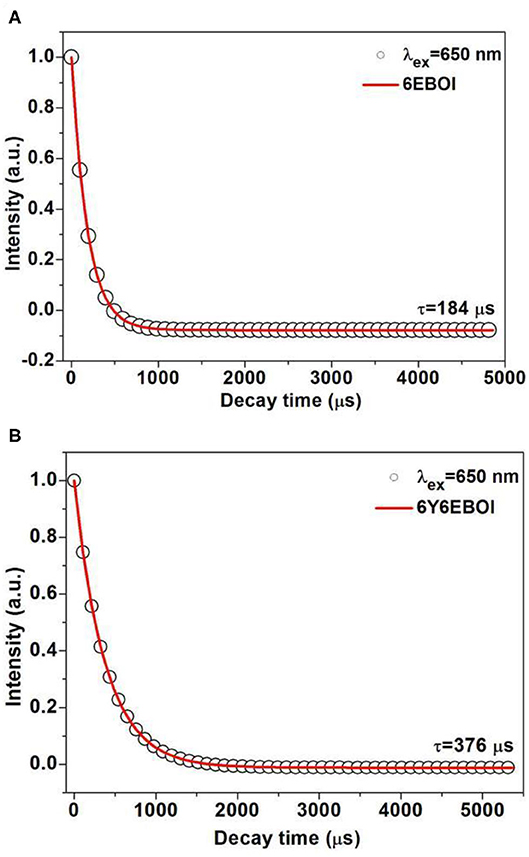
Figure 7. Decay curves of 4F9/2-4I15/2 transitions of Er3+ ions for the corresponding 6EBOI (A) and 6Y6EBOI (B) samples.
Bisphenol A (BPA) in aqueous solution is selected as target to be degraded, and the photocatalytic efficiency of the photocatalysts under visible light irradiation is shown in Figure 8. As indicated in Figure 8A, after visible light irradiation for 40 min, the photocatalytic rates of BOI, 6EBOI, 2Y6EBOI, 4Y6EBOI, 6Y6EBOI, 12Y6EBOI, and 18Y6EBOI are 14.1, 95.7, 95.9, 97.7, 100, 94.1, and 92.9, respectively. Therefore, the 6Y6EBOI sample shows the best photocatalytic performance of all the as-prepared samples in this work. According to the Langmuir–Hinshelwood kinetics model (Chen et al., 2012), the below formula is used to express the degradation process:
where C1 represents the amount of target removal object after the equilibrium is reached between adsorption and desorption (t = 0), and C represents the real-time concentration of the degradation (t). As shown in Figure S1, the k's for BOI, 6EBOI, 2Y6EBOI, 4Y6EBOI, 6Y6EBOI, 12Y6EBOI, and 18Y6EBOI samples were calculated as approximately 0.0037, 0.0829, 0.0867, 0.1025, 0.1517, 0.0725, and 0.0685 min−1 (Figure 8B), respectively. The kinetic results for pristine BOI, 6EBOI, and 6Y6EBOI samples prove the remarkable enhancement photocatalytic efficiency after Yb3+ and Er3+ doping into BOI photocatalysts.
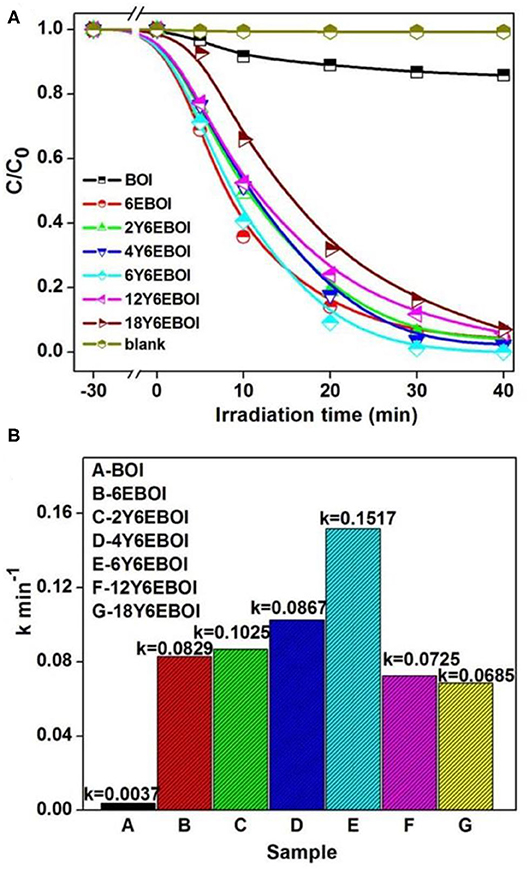
Figure 8. Variation of BPA concentration (C/C0) against photodegradation time (A) and photocatalytic reaction rate constant k (B) of BOI, 6EBOI and Yb3+/Er3+ co-doped Bi5O7I samples.
The photocatalytic activities of BOI, 6EBOI, 2Y6EBOI, 4Y6EBOI, 6Y6EBOI, 12Y6EBOI, and 18Y6EBOI samples under different wavelengths of monochromatic light were also studied. As shown in Figure 9, only 4 and 0.3% BPA was degraded under green (G) and red (R) light irradiation for 125 min over BOI, respectively. In particular, the degradation efficiencies of 6EBOI, 2Y6EBOI, 4Y6EBOI, 6Y6EBOI, 12Y6EBOI, and 18Y6EBOI samples are 69.8, 92.1, 93.6, 95.5, 81.1, and 77.3 (Figure 9A) under green light irradiation for 125 min, respectively. The degradation efficiencies of 6EBOI, 2Y6EBOI, 4Y6EBOI, 6Y6EBOI, 12Y6EBOI, and 18Y6EBOI samples are 4.8, 5.7, 10.1, 8.1, 6.4, and 5.9% under the red light irradiation for 125 min, respectively (Figure 9B). The k's of BOI, 6EBOI, 2Y6EBOI, 4Y6EBOI 6Y6EBOI, 12Y6EBOI, and 18Y6EBOI samples calculated from the data were 0.0004, 0.0097, 0.0199, 0.0218, 0.0247, 0.0131, and 0.0188 min−1 in Figure 9C under green light irradiation, and 0.00029, 0.00031, 0.00043, 0.00082, 0.00061, 0.00050, and 0.00047 min−1 in Figure 9D under the illumination of red light, respectively. These results indicate that the 6Y6EBOI sample has the most excellent photocatalytic performance for BPA degradation than pure BOI, 6EBOI, and other Er3+/Yb3+ co-doped BOI samples.
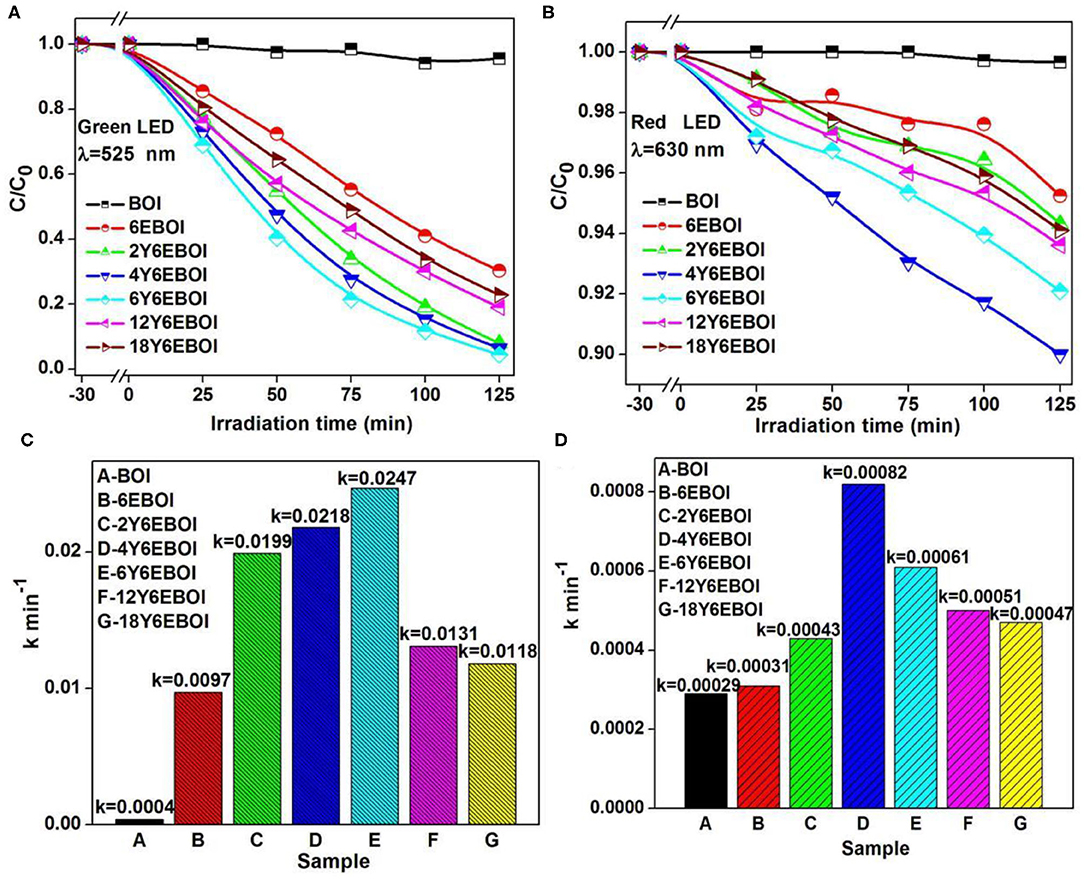
Figure 9. The photocatalytic activities of the Er3+-doped Bi5O7I (A,C) and Yb3+/Er3+-doped Bi5O7I (B,D) sample under different wavelength monochromatic light irradiation.
Apparently, the photocatalytic activity was greatly improved after the doping of Yb3+ and Er3+ with Bi5O7I under visible light irradiation. It is more interesting that the 6Y6EBOI also possesses the best photocatalytic activity under NIR light (940 nm LED light) irradiation. For comparison, BOI and 6EBOI were also used as reference photocatalysts under the same experimental condition. As exhibited in Figures 10A,B, the photodegradation efficiencies of BOI, 6EBOI, and 6Y6EBOI samples are 0.3, 1.8, and 9.4%, respectively. The characteristic peak of BPA does not show any change even when the irradiation time reached 60 min over the BOI sample (Figure 10C). However, it has an obvious decrease of the peak intensity at 277 nm of BPA with the addition of 6E6YBOI sample as shown in Figure 10D. From the above photocatalytic results, the photocatalytic activity of the 6E6YBOI photocatalyst has excellent photocatalytic performance under visible light and NIR light irradiation.
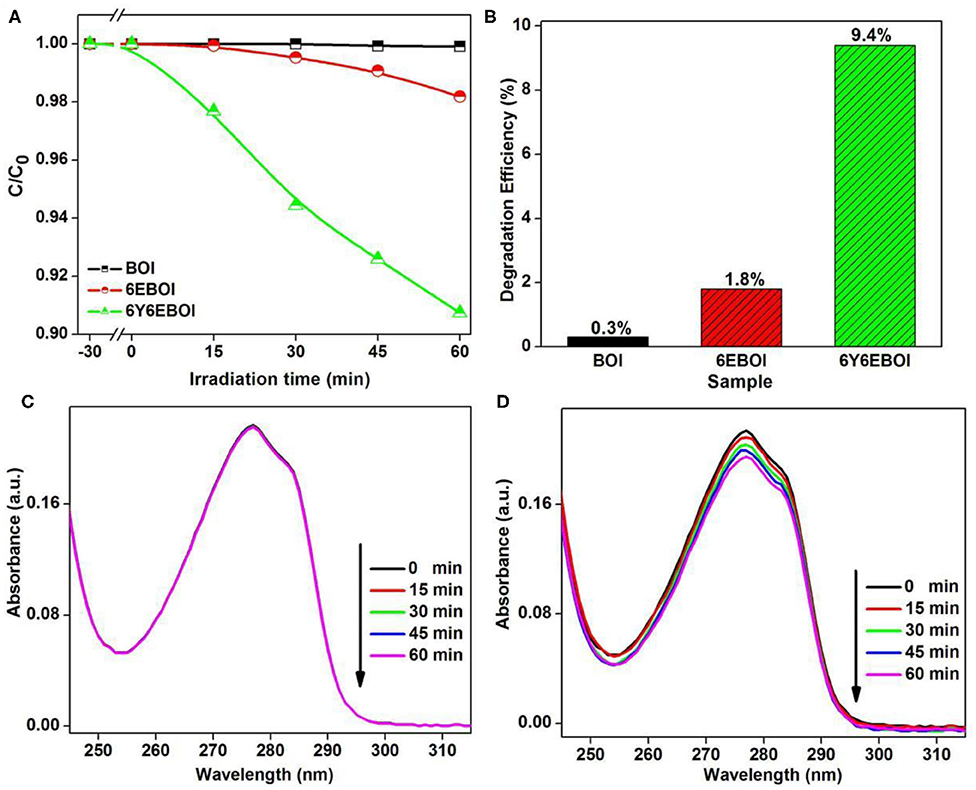
Figure 10. The photocatalytic activities (A) and degradation rate (B) of the BOI, 6EBOI, and 6Y6EBOI samples under 940-nm LED light irradiation, the variation of UV-vis spectral for the BPA in aqueous solution of BOI (C), and 6Y6EBOI (D) samples.
The transient photocurrent (I-V) and PL are effective tests in displaying the separation ability of photo-generated carriers in photocatalytic research (Chang et al., 2019; Li et al., 2020a). The responses of I-V for BOI, 6EBOI, and 6Y6EBOI were also recorded under visible light irradiation. As shown in Figure 11A, the intensity of photocurrent signal of 6E6FBOI is much stronger than the pristine BOI and 6EBOI, which suggests the best excellent effective transfer ability of photo-induced charge carriers. The PL spectra were also carried out to probe the recombination of photo-generated charge carriers (Li et al., 2020b; Nie et al., 2020). Compared with BOI and 6EBOI samples, the lowest intensity of 6Y6EBOI suggests that it possesses the lowest recombination rate of photo-generated charge carriers, which is beneficial to improve the photocatalytic activity (Figure 11B). According to above results, the Er3+ and Yb3+ doping into Bi5O7I samples shows enhancing photocatalytic degradation activities for BPA.
Figure 12 illustrates the photocatalytic reaction mechanism of the Yb3+/Er3+-doped Bi5O7I photocatalyst. It can be seen that the Yb3+/Er3+-doped Bi5O7I sample could absorb low-energy IR light, and then the electrons would be excited from the level of 2F7/2 to 2F5/2. Then, the excited electrons would be transferred back to the ground state of 2F7/2, and the energy released in this process is mainly transferred to the active Er3+ in a non-radiative manner, leading to a population of Er3+ from 4I15/2 to 4I11/2 (Wu et al., 2013). Next, a second or more similar photons from excited Yb3+ may convert to higher 4F9/2, 4F7/2, and 2I9/2 energetic levels of Er3+. Then, some of the excited electrons will relax non-radiatively to the energy levels of 2H11/2, 4S3/2, 4F9/2 etc. energy levels through a fast multiphonon decay process (Lei et al., 2015), leading to a stronger green (2H11/2, 4S3/2-4I15/2) and red emission (4F9/2-4I15/2), especially the latter. Therefore, the improvement in photocatalytic efficiency of the YEBOI samples could be elaborated more clearly in three factors. First, the Yb3+/Er3+doping in the photocatalyst can cause significant redshift with the absorption of visible light, which would excite more electron-hole pairs. Second, the upconversion process in Yb3+/Er3+-doped Bi5O7I sample will take place, and it will produce electron-hole pairs under low-energy IR light irradiation. In this process, the photoactivity of Yb3+/Er3+-doped Bi5O7I sample is evidently enhanced. Third, the Yb3+ and Er3+ in the Bi5O7I would promote the separation of e−/h+ pairs, so more photo-induced charge carriers would migrate to the sample surface for photocatalytic reaction (Zhang et al., 2012).
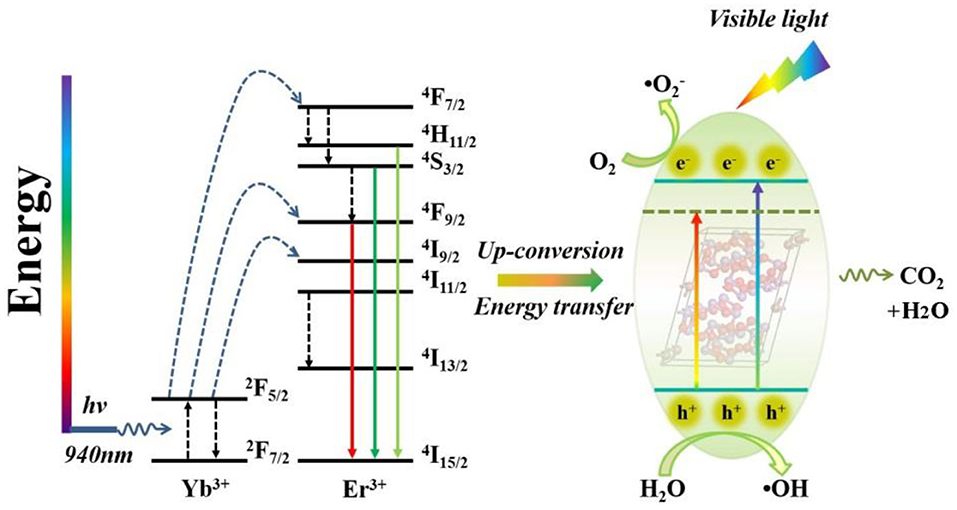
Figure 12. Schematic photodegradation mechanisms over 6Y6EBOI sample under visible light irradiation.
In this work, the Yb3+/Er3+-doped Bi5O7I microsphere photocatalysts were prepared through combining hydrothermal and heat-treatment method. The Yb3+/Er3+-doped Bi5O7I photocatalysts have excellent photocatalytic for BPA under visible light irradiation and upconversion luminescence properties. It is expected that the synthetic method and properties of this catalyst will offer some inspiration and help for the future researchers to improve similar photocatalytic and upconversion luminescence materials.
The raw data supporting the conclusions of this article will be made available by the authors, without undue reservation.
GZ designed the project. BC, SG, and LL performed the experiments. BC, SG, and RD performed the data analysis. GZ, YX, and LG contributed to the theoretical analysis. BC, SG, and SZ wrote the paper. All authors contributed to the general discussion, contributed to the article, and approved the submitted version.
This work was supported by the National Natural Science Foundation of China (Grant no. 51772183), the Key Research and Development Program of Shaanxi Province (Grant nos. 2020QFY05-04 and 2018ZDCXL-SF-02-04), and the Fundamental Research Funds for the Central Universities (Grant nos. GK201903023 and GK201801005).
The authors declare that the research was conducted in the absence of any commercial or financial relationships that could be construed as a potential conflict of interest.
The Supplementary Material for this article can be found online at: https://www.frontiersin.org/articles/10.3389/fchem.2020.00773/full#supplementary-material
Bai, Z. H., Lin, H., Johnson, J., Gui, S. C. R., Imakita, K. J., Montazami, R., et al. (2014). The single-band red upconversion luminescence from morphology and size controllable Er3+/Yb3+ doped MnF2 nanostructures. J. Mater. Chem. C 2, 1736–1741. doi: 10.1039/c3tc32143f
Chang, L. B., Zhu, G. Q., Hassan, Q., Cao, B. W., Li, S. P., Jia, Y. F., et al. (2019). Synergetic effects of Pd0 metal nanoparticles and Pd2+ ions on enhanced photocatalytic of ZnWO4 nanorods for nitric oxide removal. Langmuir 35, 11265–11274. doi: 10.1021/acs.langmuir.9b01323
Chen, L., Yin, S. F., Luo, S. L., Huang, R., Zhang, Q., and Hong, T. (2012). Bi2O2CO3/BiOI photocatalysts with heterojunctions highly efficient for visible-light treatment of dye-containing wastewater. Ind. Eng. Chem. Res. 51, 6760–6768. doi: 10.1021/ie300567y
Chuai, X., Guo, X., Liu, X., He, G., Zheng, K., He, C., et al. (2015). Bifunctional NaGdF4:Yb, Er, Fe nanocrystals with the enhanced upconversion fluorescence. Opt. Mater. 44, 13–17. doi: 10.1016/j.optmat.2015.02.019
Dai, Y., Xiao, H., Liu, J., Yuan, Q., Ma, P. A., Yang, D., et al. (2013). In vivo multimodality imaging and cancer Therapy by near-infrared light-triggered trans-Platinum pro-drug-conjugated upconverison nanoparticles. J. Am. Chem. Soc. 135, 18920–18929. doi: 10.1021/ja410028q
Ding, M. Y., Chen, D. Q., Ma, D. Y., Dai, J. B., Li, Y. T., and Ji, Z. G. (2016). Highly enhanced upconversion luminescence in lanthanide-doped active-core/luminescent-shell/ active-shell nanoarchitectures. J. Mater. Chem. C 4, 2432–2437. doi: 10.1039/C6TC00163G
Fu, J. X., Zhang, X. Z., Chao, Z. C., Li, Z. B., Liao, J. S., Hou, D. J., et al. (2017). Enhanced upconversion luminescence of NaYF4:Yb, Er microprisms via La3+ doping. Opt. Laser. Technol. 88, 280–286. doi: 10.1016/j.optlastec.2016.09.029
Hojamberdiev, M., Zhu, G. Q., Li, S. P., Zhang, Y. F., Gao, J. Z., Zhu, R. L., et al. (2020). Er3+-doping induced formation of orthorhombic/monoclinic Bi5O7I heterostructure with enhancing visible-light photocatalytic activity for removal of contaminants. Mater. Res. Bull. 123, 110701–110712. doi: 10.1016/j.materresbull.2019.110701
Hou, D. X., Gei, R., Wang, X. P., Wang, P. H., and Lim, T. T. (2012). Preparation of carbon-sensitized and Fe-Er codoped TiO2 with response surface methodology for bisphenol A photocatalytic degradation under visible-light irradiation. Appl. Catal. B Environ. 126, 121–133. doi: 10.1016/j.apcatb.2012.07.012
Huang, W. J., Lu, C. H., Jiang, C. F., Wang, W., Song, J. B., Ni, Y. R., et al. (2012). Controlled synthesis of NaYF4 nanoparticles and upconversion properties of NaYF4:Yb, Er(Tm)/FC transparent nanocomposite thin films. J. Colloid Interface Sci. 376, 34–39. doi: 10.1016/j.jcis.2012.02.047
Lan, M., Zheng, N., Dong, X. L., Hua, C. H., Ma, H. C., and Zhang, X. F. (2020). Bismuth-rich bismuth oxyiodide microspheres with abundant oxygen vacancies as an efficient photocatalyst for nitrogen fixation. Dalton Trans. 49, 9123–9129. doi: 10.1039/D0DT01332C
Lei, P. P., Zhang, P., Yuan, Q. H., Wang, Z., Dong, L. L., Song, S. Y., et al. (2015). Yb3+/Er3+-codoped Bi2O3 nanospheres: probe for upconversion luminescence imaging and bbinary contrast agent for computed tomography imaging. ACS Appl. Mater. Interfaces 7, 26346–26354. doi: 10.1021/acsami.5b09990
Li, S. J., Chen, J. L., Hu, S. W., Jiang, W., Liu, Y. P., and Liu, J. S. (2020b). A novel 3D Z-scheme heterojunction photocatalyst: Ag6Si2O7 anchored on flower-like Bi2WO6 and its excellent photocatalytic performance for the degradation of toxic pharmaceutical antibiotics. Inorg. Chem. Front. 7, 529–541. doi: 10.1039/C9QI01201J
Li, S. J., Chen, J. L., Hu, S. W., Wang, H. L., Jiang, W., and Chen, X. B. (2020a). Facile construction of novel Bi2WO6/Ta3N5 Z-scheme heterojunction nanofibers for efficient degradation of harmful pharmaceutical pollutants. Chem. Eng. J. 402:126165. doi: 10.1016/j.cej.2020.126165
Li, Z., Li, C., Mei, Y., Wang, L., Du, G., and Xiong, Y. (2013). Synthesis of rhombic hierarchical YF3 nanocrystals and their use as upconversion photocatalysts after TiO2 coating. Nanoscale 5, 3030–3036. doi: 10.1039/c3nr34018j
Lin, M., Zhao, Y., Liu, M., Qiu, M. S., Dong, Y. Q., Duan, Z. F., et al. (2014). Synthesis of upconversion NaYF4:Yb3+, Er3+ particles with enhanced luminescent intensity through control of morphology and phase. J. Mater. Chem. C. 2, 3671–3676. doi: 10.1039/C4TC00129J
Liu, C. Y., Huang, H. W., Du, X., Zhang, T. R., Tian, N., Guo, Y. X., et al. (2015). In situ co-crystallization for fabrication of g-C3N4/Bi5O7I heterojunction for enhanced visible-light photocatalysis. J. Phys. Chem. C. 119, 17156–17165. doi: 10.1021/acs.jpcc.5b03707
Liu, H., Luo, M., Hua, J. C., Zhou, T. F., Chen, R., and Li, J. L. (2013). β-Bi2O3 and Er3+ doped β-Bi2O3 single crystalline nanosheets with exposed reactive {001} facets and enhanced photocatalytic performance. Appl. Catal. B Environ. 140–141, 141–150. doi: 10.1016/j.apcatb.2013.04.009
Liu, Y. B., Zhu, G. Q., Gao, J. Z., Hojamberdiev, M., Zhu, R. L., Wei, X. M., et al. (2017). Enhanced photocatalytic activity of Bi4Ti3O12 nanosheets by Fe3+-doping and the addition of Au nanoparticles: photodegradation of phenol and bisphenol A. Appl. Catal. B Environ. 200, 72–82. doi: 10.1016/j.apcatb.2016.06.069
Ma, Y. M., Liu, H. L., Han, Z. Z., Yang, L. B., and Liu, J. H. (2015). Non-ultraviolet photocatalytic kinetics of NaYF4:Yb, Tm@TiO2/Ag Core@comby shell nanostructures. J. Mater. Chem. A. 3, 14642–14650. doi: 10.1039/C5TA03143E
Mahalingam, V., Hazra, C., Naccache, R., Vetrone, F., and Capobianco, J. A. (2013). Enhancing the color purity of the green upconversion emission from Er3+/Yb3+ -doped GdVO4 nanocrystals via tuning of the sensitizer concentration. J. Mater. Chem. C 1, 6536–6540. doi: 10.1039/c3tc31328j
Nie, J. L., Hassan, Q., Jia, Y. F., Gao, J. Z., Peng, J. H., Lu, J. B., et al. (2020). La-doped ZnWO4 nanorods with enhanced photocatalytic activity for NO removal: effects of La doping and oxygen vacancies. Inorg. Chem. Front. 7, 356–368. doi: 10.1039/C9QI01152H
Obregón, S., and Colón, G. (2014a). Heterostructured Er3+ doped BiVO4 with exceptional photocatalytic performance by cooperative electronic and luminescence sensitization mechanism. Appl. Catal. B Environ. 158–159, 242–249. doi: 10.1016/j.apcatb.2014.04.029
Obregón, S., and Colón, G. (2014b). Improved O2 evolution from a water splitting reaction over Er3+ and Yb3+ co-doped tetragonal BiVO4. Catal. Sci. Technol. 4, 2042–2050. doi: 10.1039/C4CY00050A
Obregón, S., Lee, S. W., and Colón, G. (2014). Exalted photocatalytic activity of tetragonal BiVO4 by Er3+ doping through a luminescence cooperative mechanism. Dalton Tran. 43, 311–316. doi: 10.1039/C3DT51923F
Qin, W., Zhang, D., Zhao, D., Wang, L., and Zheng, K. (2010). Near-infrared photocatalysis based on YF3:Yb3+,Tm3+/TiO2 core/shell nanoparticles. Chem. Commun. 46, 2304–2306. doi: 10.1039/b924052g
Rao, F., Zhu, G. Q., Hojamberdiev, M., Zhang, W. B., Li, S. P., Gao, J. Z., et al. (2019). Uniform Zn2+-doped BiOI microspheres assembled by ultrathin nanosheets with tunable oxygen vacancies for super-stable removal of NO. J. Phys. Chem. C 123, 16268–16280. doi: 10.1021/acs.jpcc.9b03961
Reszczynska, J., Grzybb, T., Sobczak, J. W., Lisowski, W., Gazdad, M., Ohtanie, B., et al. (2015). Visible light activity of rare earth metal doped (Er3+, Yb3+ or Er3+/Yb3+) titania photocatalysts. Appl. Catal. B Environ. 163, 40–49. doi: 10.1016/j.apcatb.2014.07.010
Rodríguez, V. D., Tikhomirov, V. K., Velázquez, J. J., Shestakov, M. V., and Moshchalkov, V. V. (2013). Visible-to-UV/Violet upconversion dynamics in Er3+-doped oxyfluoride nanoscale glass ceramics, Adv. Opt. Mater. 1, 747–752. doi: 10.1002/adom.201300212
Sun, J., Xian, J., and Du, H. (2011). Hydrothermal synthesis of BaYF5:Yb3+/Er3+ upconversion luminescence submicrospheres by a surfactant-free aqueous solution route. J. Phys. Chem. Solids 72, 207–213. doi: 10.1016/j.jpcs.2010.12.013
Wang, W., Huang, W. J., Ni, Y. R., Lu, C. H., Tan, L. J., and Xu, Z. Z. (2013). Graphene supported β-NaYF4:Yb3+,Tm3+ and N-doped P25 nanocomposite as an advanced NIR and sunlight driven upconversion photocatalyst. App. Surf. Sci. 282, 832–837. doi: 10.1016/j.apsusc.2013.06.066
Wang, Y. F., Xu, W., Zhu, Y. S., Xu, S., Cui, H. N., and Song, H. W. (2014). Phonon-modulated upconversion luminescence properties in some Er3+ and Yb3+ co-activated oxides. J. Mater. Chem. C 2, 4642–4650. doi: 10.1039/c4tc00330f
Wu, X. Y., Yin, S., Dong, Q., Liu, B., Wang, Y. H., Sekino, T., et al. (2013). UV, visible and near-infrared lights induced NOx destruction activity of (Yb,Er)-NaYF4/C-TiO2 composite. Sci. Rep. 3, 2911–2918. doi: 10.1038/srep02918
Xu, D. X., Lian, Z. W., Fu, M. L., Yuan, B. L., Shi, J. W., and Cui, H. J. (2013). Advanced near-infrared-driven photocatalyst: fabrication, characterization, and photocatalytic performance of β-NaYF4:Yb3+,Tm3+@TiO2 core@shell microcrystals. Appl. Catal. B Environ. 142–143, 377–386. doi: 10.1016/j.apcatb.2013.05.062
Xu, J. S., Brenner, T. J. K., Chen, Z. P., Neher, D., and Antonietti, M. (2014). Upconversion-agent induced improvement of g-C3N4 photocatalyst under visible light. ACS Appl. Mater. Interfaces 6, 16481–16486. doi: 10.1021/am5051263
Zhang, J., Dai, S., Wang, G., Zhang, L., Sun, H., and Hu, L. (2005). Investigation on upconversion luminescence in Er3+/Yb3+codoped tellurite glasses and fibers. Phys. Lett. A 345, 409–414. doi: 10.1016/j.physleta.2005.07.014
Zhang, J. Y., Zhu, G. Q., Li, S. P., Rao, F., Hassan, Q., Gao, J. Z., et al. (2019). Novel Au/La-Bi5O7I microspheres with efficient visible-light photocatalytic activity for NO removal: synergistic effect of Au nanoparticles, La doping and oxygen vacancy. ACS Appl. Mater. Interfaces 41, 37822–37832. doi: 10.1021/acsami.9b14300
Zhang, L., Wang, W. Z., Sun, S. M., Zhang, Z. J., Xu, J. H., and Ren, J. (2012). Photocatalytic activity of Er3+, Yb3+ doped Bi5O7I. Catal. Commun. 26, 88–92. doi: 10.1016/j.catcom.2012.04.021
Zhang, L. L., Sha, J. N., Chen, R. R., Liu, Q., Liu, J. Y., Yu, J., et al. (2020a). Surface plasma Ag-decorated Bi5O7I microspheres uniformly distributed on a zwitterionic fluorinated polymer with superfunctional antifouling property. Appl. Catal. B Environ. 271:118920. doi: 10.1016/j.apcatb.2020.118920
Zhang, L. L., Sha, J. N., Chen, R. R., Liu, Q., Liu, J. Y., Yu, J., et al. (2020b). Three-dimensional flower-like shaped Bi5O7I particles incorporation zwitterionic fluorinated polymers with synergistic hydration-photocatalytic for enhanced marine antifouling performance. J. Hazard. Mater. 389:121854. doi: 10.1016/j.jhazmat.2019.121854
Zhou, J. J., Chen, G. X., Zhu, Y. B., Huo, L. L., Mao, W., Zou, D. N., et al. (2015). Intense multiphoton upconversion of Yb3+-Tm3+ doped β-NaYF4 individual nanocrystals by saturation excitation. J. Mater. Chem. C 3, 364–369. doi: 10.1039/C4TC02363C
Keywords: doping, semiconductor, microsphere, upconversion, heterojunction photocatalytic activity, NO removal, Rhodamine B
Citation: Cao B, Gong S, Zubairu SM, Liu L, Xu Y, Guo L, Dang R and Zhu G (2020) Fabrication of Er3+/Yb3+ Co-Doped Bi5O7I Microsphere With Upconversion Luminescence and Enhanced Photocatalytic Activity for Bisphenol A Degradation. Front. Chem. 8:773. doi: 10.3389/fchem.2020.00773
Received: 26 June 2020; Accepted: 24 July 2020;
Published: 03 September 2020.
Edited by:
Shijie Li, Zhejiang Ocean University, ChinaReviewed by:
Zhifeng Liu, Tianjin Chengjian University, ChinaCopyright © 2020 Cao, Gong, Zubairu, Liu, Xu, Guo, Dang and Zhu. This is an open-access article distributed under the terms of the Creative Commons Attribution License (CC BY). The use, distribution or reproduction in other forums is permitted, provided the original author(s) and the copyright owner(s) are credited and that the original publication in this journal is cited, in accordance with accepted academic practice. No use, distribution or reproduction is permitted which does not comply with these terms.
*Correspondence: Gangqiang Zhu, emdxMjAwNkBzbm51LmVkdS5jbg==
Disclaimer: All claims expressed in this article are solely those of the authors and do not necessarily represent those of their affiliated organizations, or those of the publisher, the editors and the reviewers. Any product that may be evaluated in this article or claim that may be made by its manufacturer is not guaranteed or endorsed by the publisher.
Research integrity at Frontiers

Learn more about the work of our research integrity team to safeguard the quality of each article we publish.